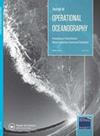对两个全球海洋预报系统卫星海面盐度数据的观测影响说明
IF 2.4
3区 地球科学
Q4 METEOROLOGY & ATMOSPHERIC SCIENCES
引用次数: 4
摘要
摘要利用两个海洋数据同化系统进行了观测系统实验,以评估同化卫星海面盐度(SSS)数据的影响。在英国气象局和墨卡托海洋系统中,SSS数据使热带太平洋盐度的误差分别降低了4%和8%,平均影响深度约为50米。在两个系统中,热带大西洋的盐度误差减少了30%。在Met Office系统中,热带太平洋中部和亚马逊河流出区近地表温度和海平面异常误差都有显著降低。实际海洋预报系统的试验结果和特点对卫星盐度数据提出了新的要求。要显著提高实时海洋分析和预报所需的产品精度,在至少50公里的分辨率下,每日产品的精度应低于0.2秒。将空间分辨率提高到10公里左右将是一个更重大的突破。为了接近实时地同化,产品应在24小时内可用,并且每次测量都应提供不确定度的系统和随机成分的估计。本文章由计算机程序翻译,如有差异,请以英文原文为准。
Observation impact statement on satellite sea surface salinity data from two operational global ocean forecasting systems
ABSTRACT Observing system experiments have been carried out with two operational ocean data assimilation systems to assess the impact of assimilating satellite sea surface salinity (SSS) data. The SSS data reduces the errors in tropical Pacific salinity by 4% and 8% in the Met Office and Mercator Ocean systems respectively with an impact down to about 50 m depth on average. Salinity errors were reduced by up to 30% in the tropical Atlantic in both systems. There were significant reductions in near-surface temperature and sea level anomaly errors in both the central tropical Pacific and Amazon outflow regions in the Met Office system. The experiment results and characteristics of the operational ocean forecasting systems lead to a new set of requirements for satellite salinity data. The product accuracy required to significantly improve real-time ocean analysis and forecasts should be less than 0.2 pss at a resolution of at least 50 km for daily products. Improvements to spatial resolution down to the order of 10 km would represent an even more significant breakthrough. To be assimilated in near-real time, products should be available within 24 h and estimates of the systematic and random components of the uncertainty should be provided with each measurement.
求助全文
通过发布文献求助,成功后即可免费获取论文全文。
去求助
来源期刊
CiteScore
7.50
自引率
9.70%
发文量
8
审稿时长
>12 weeks
期刊介绍:
The Journal of Operational Oceanography will publish papers which examine the role of oceanography in contributing to the fields of: Numerical Weather Prediction; Development of Climatologies; Implications of Ocean Change; Ocean and Climate Forecasting; Ocean Observing Technologies; Eutrophication; Climate Assessment; Shoreline Change; Marine and Sea State Prediction; Model Development and Validation; Coastal Flooding; Reducing Public Health Risks; Short-Range Ocean Forecasting; Forces on Structures; Ocean Policy; Protecting and Restoring Ecosystem health; Controlling and Mitigating Natural Hazards; Safe and Efficient Marine Operations

 求助内容:
求助内容: 应助结果提醒方式:
应助结果提醒方式:


